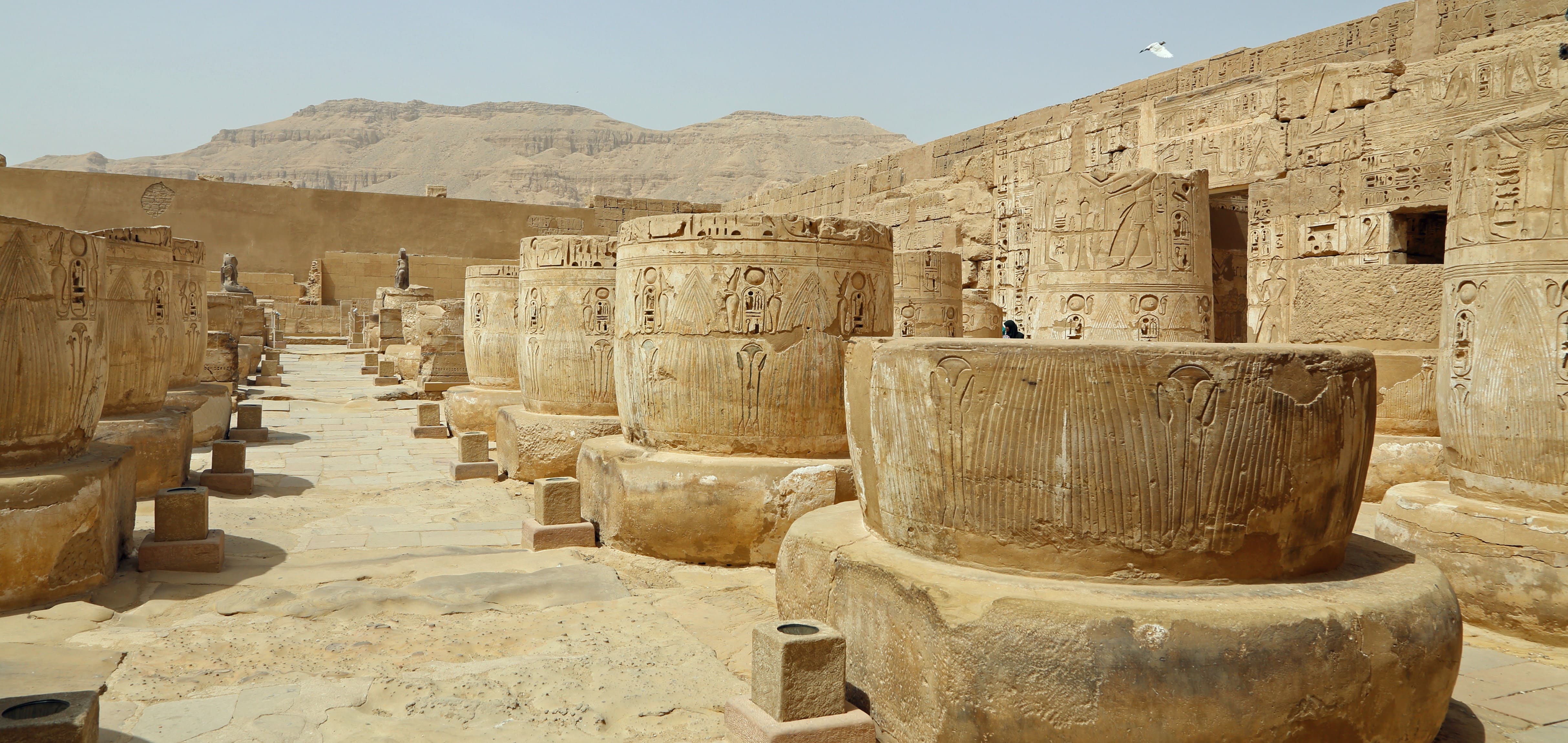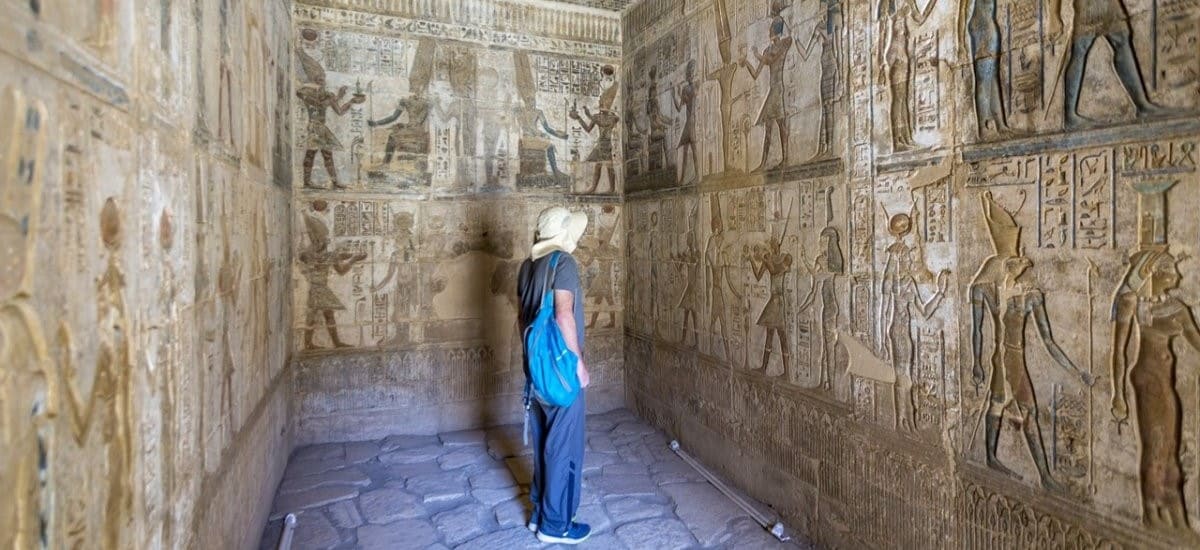Medinet Habu: The Mortuary Temple of Ramesses III
Luxor, the city of a hundred gates, is home to some of the most breathtaking monuments of ancient Egypt. Among these wonders is Medinet Habu which stands out as a masterpiece of architecture and history. It is a magnificent structure located near the foot of the Theban Hills on the West Bank of the River Nile opposite the modern city of Luxor. Medinet Habu is one of the best-preserved memorial temples from the New Kingdom period. This vast complex offers a fascinating glimpse into ancient Egyptian architecture, religion, and history. It stands as a testament to the grandeur and power of Egypt’s New Kingdom and the powerful legacy of one of its most formidable pharaohs.
The archaeological wonder of Medinet Habu is a fortified construction that was a highly important religious center dedicated to the God Amun and a Pharaonic power base within western Egypt. It was used in times of conflict for protection for the western inhabitants of Thebes and as a center for the Dayr al-Madinah women's village. The complex was also a walled and fortified town for the Coptic Christians in the 9th century AD. It was designed to display military might and celebrate victory in battles against the sea people, Libyans, and Nubians.
.jpg)
Medinet Habu is also renowned for its exceptionally well-preserved reliefs and inscriptions, which provide invaluable insights into the religious practices, daily life, and historical events of the New Kingdom. The detailed carvings depict everything from grandiose battle scenes to intimate moments of worship.
Beyond its architectural and artistic achievements, Medinet Habu holds significant historical value. The inscriptions within the temple provide a wealth of information about the political, economic, and social aspects of Ramesses III’s reign. These records are critical for understanding the political and social dynamics of the late New Kingdom. For instance, the inscriptions document the pharaoh's efforts to restore order and prosperity following the turmoil of the late 19th Dynasty, highlighting his role as a stabilizing force during political unrest.
Today, visiting Medinet Habu offers a unique opportunity to step back in time and explore the grandeur of ancient Egypt. It remains one of the best-preserved ancient structures in Egypt and a popular tourist destination, attracting visitors from around the world. In collaboration with international organizations, the Egyptian government has made significant efforts to preserve this monumental site. Conservation projects focus on protecting the temple's delicate reliefs and inscriptions from environmental damage and human impact. These efforts ensure that future generations can continue to marvel at Medinet Habu's splendor and learn from its historical and cultural heritage.
The History of Medinet Habu
Medinet Habu, originally known as Djeme, is the second-largest ancient temple ever discovered in Egypt, covering a total area of more than 66,000 square meters. It was built during the New Kingdom (1570 – 1050 BC) specifically as a mortuary temple by Ramesses III who was the second pharaoh of the 20th dynasty, and also the last great pharaoh of the New Kingdom. It was constructed to honor Amun, the chief god of Thebes. Ramses III wanted to create a grand temple complex that would befit his status as pharaoh and reflect his power and prestige. The temple complex included a large central temple, surrounded by smaller temples dedicated to other gods and goddesses and courtyards, gardens, and other structures.
.jpg)
Medinet Habu became an important religious site during the New Kingdom. In addition to its religious significance, Medinet Habu served as an administrative center for Ramses III's government. Records show that it housed several government offices, including those responsible for taxation, law enforcement, military recruitment, trade regulation, food distribution, and more.
Medinet Habu remained an important religious site until it was abandoned sometime around 700 BCE when it became part of Coptic Christian monasteries in Luxor. In modern times it has become one of Egypt's most popular tourist attractions due to its well-preserved state and historical importance. Visitors can still see many of the original reliefs on its walls today, which provide insight into ancient Egyptian culture and religion.
The Architectural Marvels of Medinet Habu
Medinet Habu is known for its impressive architecture, featuring intricate carvings, impressive columns, and colorful hieroglyphics. The temple complex is surrounded by towering mudbrick walls, reflecting its dual role as a sanctuary and a defensive fortress. This protective aspect is unique among New Kingdom temples, underscoring the tumultuous period during which it was built. The architectural layout follows the traditional New Kingdom temple design, with pylons, courtyards, hypostyle halls, and sanctuaries. However, the scale and intricacy of the reliefs and inscriptions set it apart as one of Egypt's most remarkable structures.
The First Pylon and Courtyard
.jpg)
The entrance to Medinet Habu is marked by the imposing First Pylon, towering at 63 meters wide and adorned with vivid reliefs depicting Ramesses III’s military victories. These scenes not only celebrate the pharaoh’s prowess but also serve as historical records of his reign. Beyond the pylon lies the First Courtyard, surrounded by a colonnade with statues of the pharaoh in Osiride form, symbolizing his divine nature and eternal life. This courtyard served as a public space for rituals and gatherings, emphasizing the temple's role as a communal and religious center.
The Hypostyle Hall

The Hypostyle Hall, one of the most breathtaking spaces in the temple, is filled with towering columns decorated with scenes of religious rituals and offerings. These columns, arranged in rows, create a forest of stone that supports a ceiling adorned with astronomical motifs, highlighting the Egyptians’ advanced understanding of the cosmos. The hall's walls are covered with scenes of religious rituals and offerings, depicting Ramesses III interacting with various deities. This sacred space underscores the close relationship between the pharaoh and the gods, reinforcing his divine right to rule.
Sea Peoples at Medinet Habu
One of the most striking features of Medinet Habu is the depiction of battles against a group of seafaring warriors known as the sea people who invaded Egypt during Ramses III's reign. Their attacks on Egypt caused great destruction throughout the country, but Ramses III eventually repelled them with his powerful army. These reliefs are not only artistic masterpieces but also crucial historical records, offering a glimpse into the military challenges faced by the pharaoh. The scenes vividly illustrate the chaos and intensity of warfare, with detailed representations of soldiers, chariots, and prisoners. The records show also the victories of three great Pharaohs, Ramesses II (1279-1213 BCE), his son and successor Merenptah (1213-1203 BCE), and Ramesses III (1186-1155 BCE) over the sea people at the battle of Djahy. For over a century, they were seen as a constant challenge to the prosperity of Egypt. All these facts are mentioned on Medinet Habu displaying valuable historical information about these events.
The Temple of Ramesses III
Visitors to Medinet Habu typically enter the site via a giant gateway that has two huge columns on either side. After passing through the gateway one can see the ruins of Ramesses III's royal palace. It was the last of the great funerary structures to be built in Western Thebes. The temple, some 150 m long, is of orthodox design and has a design similar to the close mortuary temple of Ramesses II, the Ramesseum. The original entrance of the temple is through a powerful stronghold gatehouse, known as a migdol. The temple is also filled with highly preserved walls surrounded by a substantial fortified mudbrick enclosure. Just inside the enclosure, to the south, are many chapels dedicated to the Divine Adoratrices of Amun.
.jpg)
The first pylon leads into an open courtyard, lined with massive statues of Ramesses III as Osiris on one side, and uncarved columns on the other. The second pylon leads into a peristyle hall, again featuring columns of Ramses III. This leads up a ramp that leads to the third pylon and then into the large hypostyle hall which is home to many well-preserved decorations and reliefs that symbolize the Pharaoh’s control over regions like Nubia and Syria.
Just left of the entrance to the Mortuary Temple of Ramesses III, there is also a small temple dedicated to the god Amun dating to the 18th Dynasty. This temple was originally built by Queen Hatshepsut and then later altered by King Tuthmosis III before being modified once again during the Roman period. The Temple of Amun is one of Egypt's most remarkable ancient monuments. It is a testament to the grandeur and power of the ancient Egyptians, who constructed this Temple in honor of their god, Amun-Ra.

In Conclusion, Medinet Habu stands as a monumental tribute to the architectural ingenuity, artistic excellence, and historical significance of ancient Egypt. As one of Luxor’s most impressive sites, it offers a profound connection to the past, inviting visitors to explore the enduring legacy of Ramesses III and the civilization he ruled. Whether you're a history enthusiast, an art lover, or a casual traveler, Medinet Habu is a must-visit destination that promises to leave an indelible mark on your understanding of ancient Egypt.
Also: Don't miss out on the chance to explore the rich history of Luxor and check out our Tours from Here